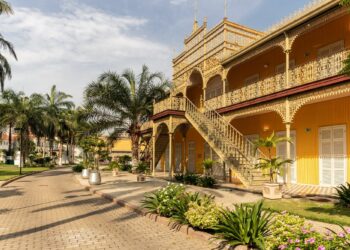Art Dubai has established itself as one of the world’s leading global art fairs. Whilst its roots were originally set in the Middle East, North Africa and South Asia (MENASA), Art Dubai has evolved over the years to become a vibrant meeting ground between established and trail-blazing emerging artists, collectors and art connoisseurs, and a vital link between the art ecosystems of Europe and the Americas with the Arab world, Africa and Asia.
Over the past seven years ART AFRICA has maintained a partnership with the fair and experienced these developments first hand. We believe that this platform in particular has an important place to play for Africa as it continues to emerge more prominently on the global art scene. Besides being a cultural powerhouse and center of creativity, Art Dubai harnesses the incredible spirit of collaboration and artistic energy of the region.
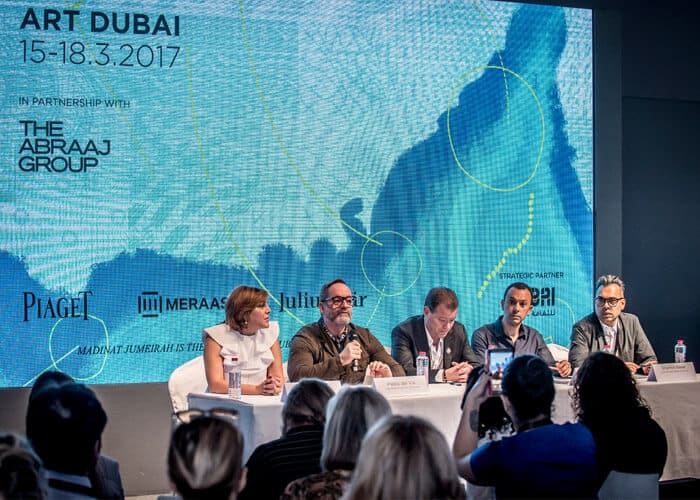 Art Dubai Press Conference, 2017. Seated from left to right: Myrna Ayad, Fair Director, Art Dubai; Pablo del Val, International Fair Director; Frederic Sicre, Managing Director, The Abraaj Group; Omar Berrada, Curator, The Abraaj Group Art Prize; Shumon Basar, Commissioner, Global Art Forum. Image courtesy of Photo Solutions.
Art Dubai Press Conference, 2017. Seated from left to right: Myrna Ayad, Fair Director, Art Dubai; Pablo del Val, International Fair Director; Frederic Sicre, Managing Director, The Abraaj Group; Omar Berrada, Curator, The Abraaj Group Art Prize; Shumon Basar, Commissioner, Global Art Forum. Image courtesy of Photo Solutions.
ART DUBAI 2017
The eleventh edition of Art Dubai opened its doors to the public on March 14th, 2017. Held under the patronage of HH Sheikh Mohammed bin Rashid Al Maktoum, Vice President and Prime Minister of the UAE and Ruler of Dubai, and under the new leadership of Fair Director Myrna Ayad and International Director Pablo del Val, this year’s fair was the largest and most international to date, with new galleries and countries participating for the first time, alongside ambitious new elements to the programming.
Featuring 94 galleries from 43 countries, with 27 galleries attending for the first time, Art Dubai continued its mandate to offer unrivaled access to art from across the globe, reinforcing its position as the world’s most globally diverse art fair as well as the preeminent platform for the regional art scene.
This year, Art Dubai Contemporary featured 79 galleries spread across its two gallery halls, including a selection of 30+ galleries focusing on solo or two-artist exhibitions. Art Dubai Modern, now in its fourth edition, continued to be the only platform dedicated to showcasing museum-quality works by Modern masters from the Middle East, Africa and South Asia.
“Visitors will see more tightly curated exhibitions in the gallery halls this year,” said Art Dubai’s International Director Pablo del Val, prior to its opening. “The presentations are split between solo or two-artist exhibitions, allowing a more focused contemplation; and multi-artist shows, enabling an overview of different works. In addition, we are introducing new galleries and countries to the fair this year, with our highest-ever number of galleries from Latin America, and galleries from Algeria, Peru and Uruguay attending for the first time.”
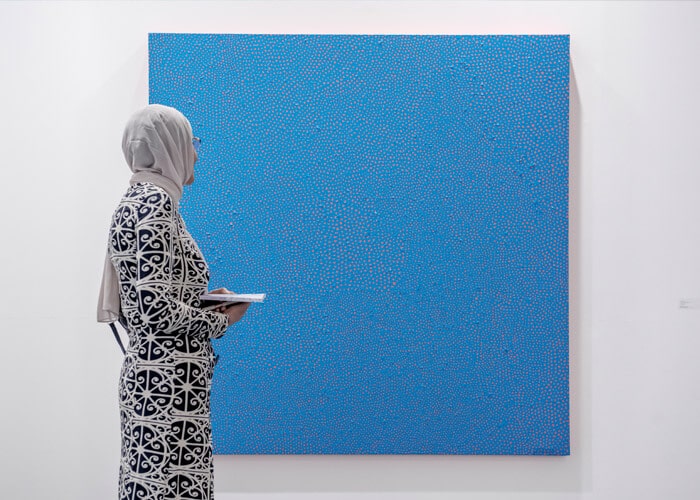 Art Dubai Contemporary, Ota Fine Arts, Art Dubai 2017. Image courtesy of Art Dubai.
Art Dubai Contemporary, Ota Fine Arts, Art Dubai 2017. Image courtesy of Art Dubai.
ART DUBAI EXHIBITION HALLS
ART DUBAI | CONTEMPORARY GALLERIES
Affirming Art Dubai’s reputation as the most global of art fairs, this year the Contemporary Halls included 79 galleries from 41 countries, selected via a stringent independent review process.
In 2017, galleries presented tightly curated solo or group shows and audiences discovered artists from galleries spanning across the world – from Sao Paulo to Melbourne, including the largest exhibition of contemporary art from the region. The works these galleries presented covered all artistic media including painting, drawing, sculpture, installation, video, photography and performance.
Always aiming to foreground quality and a curatorial approach, Art Dubai has a close relationship with its galleries, the artists they represent, and the works they select – reconfirming year-on-year the fair’s role as a site of discovery and diversity.
ART DUBAI | MODERN GALLERIES
Art Dubai launched a programme for 20th century art in 2014. Now in its fourth iteration, Art Dubai Modern featured 15 booth exhibitions, each a solo or two-person show, featuring work by modern masters, from the Middle East, South Asia and Africa, whose work has been influential throughout the 20th century. The proposals were reviewed by an advisory board, comprising curators and art historians with a particular interest in modernist practices of the Middle East and Asia.
The 2016-2017 Art Dubai Modern curatorial committee includes Savita Apte, and art historian specialising in modern and contemporary South Asian Art; Dr. Iftikhar Dadi, associate professor in Cornell University’s department of History of Art, and author of Modernism and the Art of Muslim South Asia (2010); Catherine David, a renowned curator with extensive experience in the Middle East, whose exhibitions include Documenta X; Kristine Khouri, a researcher and a writer based in Beirut and co-founder of the History of Arab Modernities in the Visual Arts Study Group; Dr. Nada Shabout, an art historian specialising in modern Arab and Iraqi art and Professor of Art History and the Director of the Contemporary Arab and Muslim Studies Initiative (CAMCSI) at the University of North Texas.
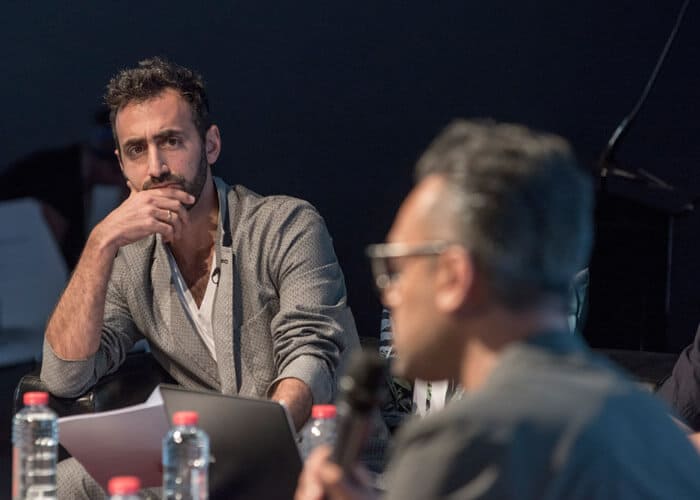 Global Art Forum, Trading Places, Art Dubai 2017. Image courtesy of Photo Solutions.
Global Art Forum, Trading Places, Art Dubai 2017. Image courtesy of Photo Solutions.
GLOBAL ART FORUM
Trade is at the heart of humankind. Trade connects people to one another in a myriad of ways, both seen and unseen. Trade can fuel civilisations and empires. It can dictate time itself. The end of trade turns somewhere suddenly and into nowhere.
– Shumon Baser
– Shumon Baser
The Global Art Forum was launched by Art Dubai at its inaugural fair in 2007. In 2017, it was presented by the Dubai Culture and Arts Authority and supported by Dubai Design District (d3).
Featuring live talks guided by a curated theme, the Forum brought together a diverse line-up of artists, curators, musicians, strategists, thinkers and writers.
The 11th edition of the Global Art Forum focused on the trade of goods and ideas that shape and reshape the world. Titled Trading Places, the Forum was conceived by Shumon Baser as Commissioner, with Antonia Carver and Oscar Guardiola-Rivera as Co-directors.
Trading Places was inaugurated on Friday January 13th, 2017, at Dubai Design District with an evening of conversations, presentations and performances. On Saturday January 14th, 2017, the Forum shifted to Sharjah with a series of unique, guided tours through the city-fabric and its richly layered tales of trade. The Forum continued as Art Dubai, which was on from the 15th until the 17th of March.
Trading Places explores the relationship between the economy of goods and ideas that constantly shape who and where we are. From ancient ports to the ‘New Silk Road’ to algorithmic financial markets, the infrastructure of trade is also a geography of imagination and invention. It is also the foundation upon which Dubai and sibling Gulf cities have forged their pasts and their futures, from pearls to airports.
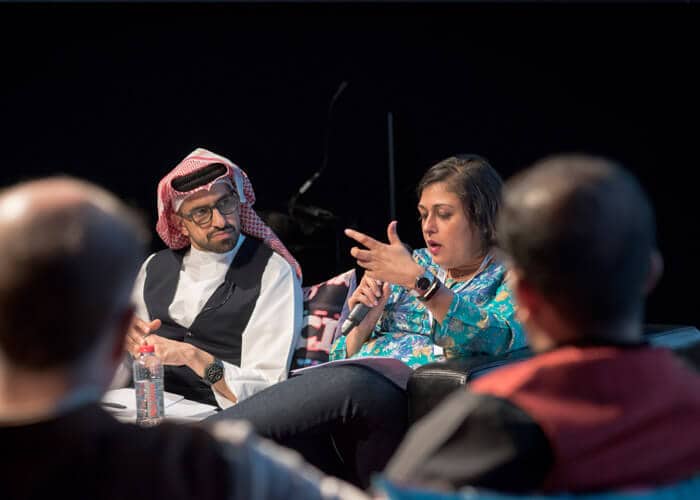 Global Art Forum, Trading Places, Art Dubai 2017. Image courtesy of Photo Solutions.
Global Art Forum, Trading Places, Art Dubai 2017. Image courtesy of Photo Solutions.
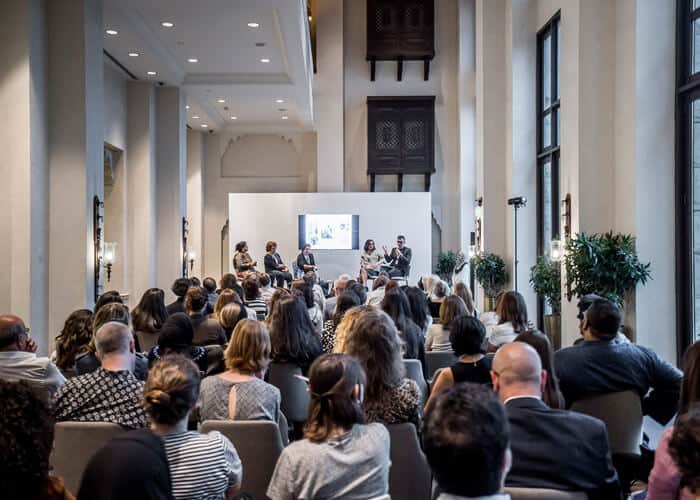 Art Dubai Modern Symposium, Day One opening. Image courtesy of Photo Solutions.
Art Dubai Modern Symposium, Day One opening. Image courtesy of Photo Solutions.
DUBAI MODERN SYMPOSIUM
For its eleventh edition, and to complement the fair’s Modern Hall, Art Dubai introduced the inaugural Art Dubai Madern Symposium – a series of talks and presentations focused on the life, work and cultural impact of 20th century masters from the Middle East, South Asia and Africa, Dubai Modern Symposium took place at Concrete in Alserkal Avenue.
Renowned curators, scholars and patrons lead the sessions that delved into styles and practices of artists whose work contributes to the history of art produced in the 20th century.
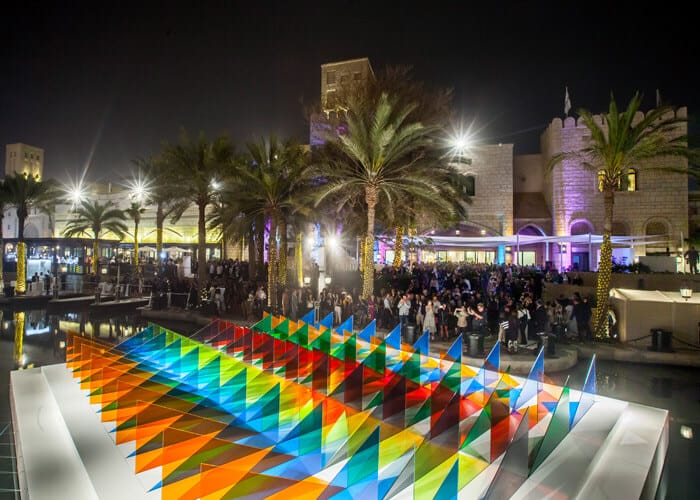 Abraaj Group Art Prize 2017, the unveiling of Rana Begum’s work, Art Dubai. Image courtesy of Photo Solutions.
Abraaj Group Art Prize 2017, the unveiling of Rana Begum’s work, Art Dubai. Image courtesy of Photo Solutions.
THE ABRAAJ GROUP PRIZE
The Abraaj Group Art Prize was launched in 2008, with the goal of nurturing home-grown talent and providing them with unparalleled growth opportunities, as well as showcasing their work to an international audience. Since then, the Abraaj Group Art Prize has grown to be among the most highly coveted art awards globally, empowering artists from MENASA to develop their practices on a global platform.
Reflecting the region’s thriving art community, the Group received a record number of applications from 94 countries this year, more than double the number received in the previous year. This year’s winner, Rana Begum, has demonstrated a complex and rare use of colours, glass and beautiful geomentric shapes in her work to evoke temporal experiences. Her winning exhibit, along with carefully selected pieces from shortlisted artists Doa Aly, Sarah Abu Abdallah and Raha Raissnia were unveiled in an exhibition, seepage/ritual, curated by Omar Berrada at Art Dubai 2017.
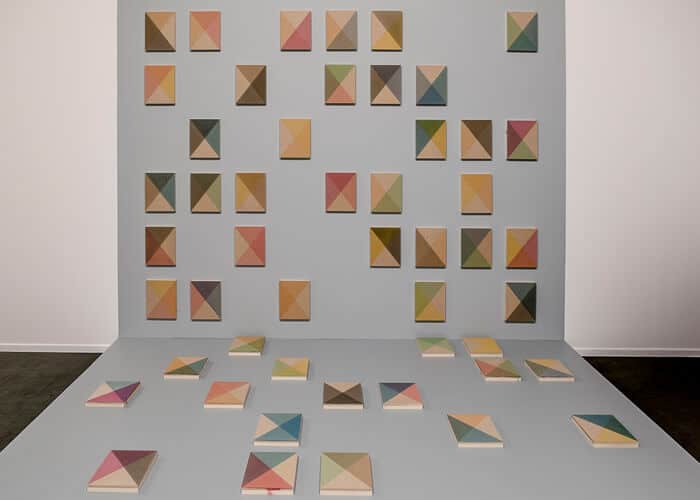 Abraaj Group Art Prize exhibition 2017, Rana Begum. Images courtesy of Photo Solutions.
Abraaj Group Art Prize exhibition 2017, Rana Begum. Images courtesy of Photo Solutions.
SEEPAGE / RITUAL
Reality is fluid. It constantly evades our grasp, revealing its ever-unheeded dimensions. How do you elaborate forms in response to social, political or historical tumult? How do you face up to the excesses of the real, or attend to its silences? There is where we meet. In a short story collection by the title Here is Where we Meet, John Berger captures multiple encounters with cities through narrative capsules of thought, memory and emotion.
Here, in Dubai, is where they meet: four artists with a strong interest in architecture, urban space and seriality. Here is how they meet: through repetition and variation of pattern and rhythm, each in her own way explores aesthetic modes of coaxing reality into form. The show is thus a series of propositions on how to stage a dialectics of excess and control – of seepage and ritual.
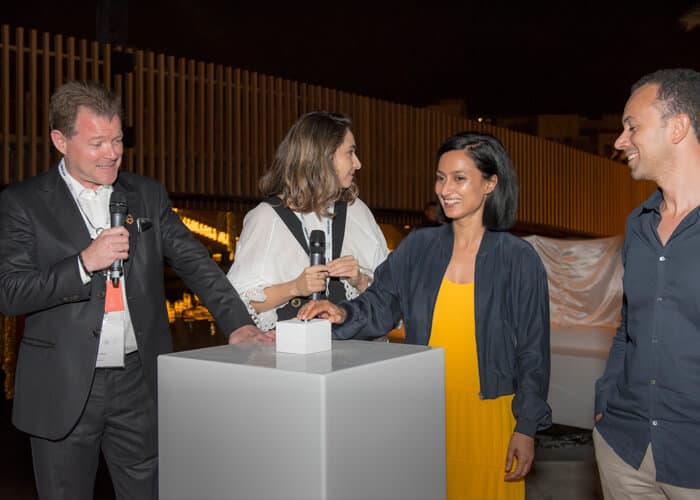 Abraaj Group Art Prize exhibition 2017, Raha Raissnia, Doa Aly, Rana Begum. Images courtesy of Photo Solutions.
Abraaj Group Art Prize exhibition 2017, Raha Raissnia, Doa Aly, Rana Begum. Images courtesy of Photo Solutions.
By integrating variations of daylight into here work, Rana Begum turns sculpture into a time-based art form while conveying a sense of infinity through the repetition of simple geometric patterns. In Doa Aly’s video installation, strictly choreographed movements of bodies in space are offset by the competing layers of an intricate soundtrack. Raha Raissnia’s paintings, drawings and film projections follow a logic of visual counterpoint while foregrounding dark, forbidding architectures in which the occasional opening appears as a small miracle. Sarah Abu Abdallah embraces the domestic within her own aesthetics of confinement where by virtue of endlessly observing quotidian minutiae, reality breaks into separate parts enigmatically linked.
Omar Berrada is a writer, translator, and curator currently living in New York. He is one of the editors of Tamawuj, the online publication of Sharjah Biennale 13, and is at work on book and exhibition projects relating to the archive of Moroccan writer and filmmaker, Ahmed Bouanani.
RANA BEGUM | ARTIST’S STATEMENT
The work of London-based Rana Begum focuses on spatial and visual experience, refelecting on presence and contemplation. Through her refined language of minimalist abstraction, Begum blurs the boundaries between sculpture, painting and architecture. Her practice draws inspiration from both the vibrancy and disarray of urban landscapes and the distilled repetition of geometric patterns, which abound in traditional Islamic art and architecture.
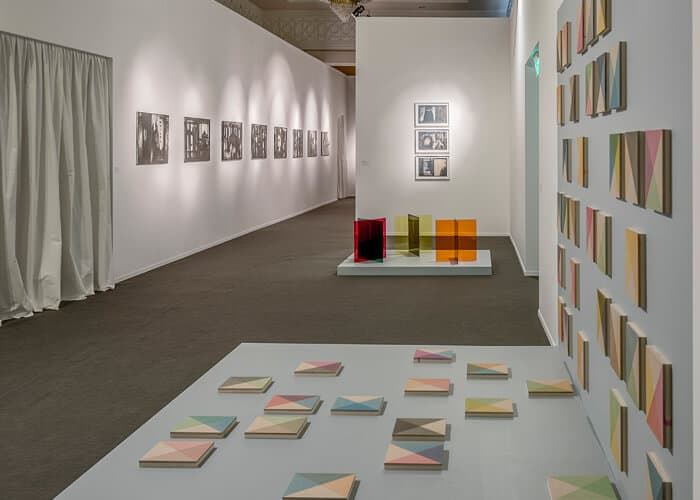 Abraaj Group Art Prize 2017, Unveiling Ceremony. Images courtesy of Photo Solutions.
Abraaj Group Art Prize 2017, Unveiling Ceremony. Images courtesy of Photo Solutions.
The work commissioned by the Abraaj Group Art Prize reiterates Begum’s interest in the interplay between light and colour. The commission stems from a series of studies on MDF panels that focus on overlapping , transparent coloured planes which create a third layer of geometry and colour. This interaction was the starting point which led Begum to explore these concerns further and make them more concrete. These paintings become more physical through the use of transparent glass which allow the viewer to see how light, colour and form come together in an open space.
Presented on a floating platform, the large-scale installation invites the viewer to walk around the work and experience the ever-changing reflections of glass panels. Within this composition, time itself becomes visible as viewers take in the movement of light throughout the day. Begum captures a combined sense of ephemeral and transcendental.
Born in Bangladesh in 1977, Rana Begum lives and works in London. She graduated in 2002 with an MFA in painting from the Slade School of Fine Art. Her work has been exhibited in Institutions including Parasol Unit (London), Tensta Konsthal (Stockholm), Delfina Foundation (London), Royal Academy of Arts (London), Samuel Dorsky Museum of Art (New York), Gemeente Museum Den Hague (The Hague) and MRAC Serignan (Serignan).
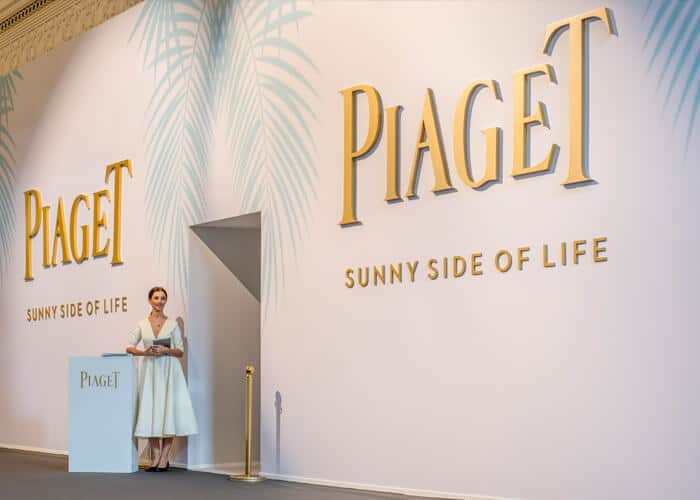 Piaget ‘Sunny Side of Life’ exhibition, Art Dubai 2017. Image courtesy of Photo Solutions.
Piaget ‘Sunny Side of Life’ exhibition, Art Dubai 2017. Image courtesy of Photo Solutions.
PIAGET
Piaget is very excited to continue their collaboration with Art Dubai. Our common constant search of innovation and celebration of creativity are two traits that are very much engraved in our DNA.
This partnership comes as a natural continuation to Piaget’s longstanding commitment to creative design, collaboration with famous artists such as Dali, Andy Warhol, and much more and in the perpetuation of rare craftsmanship skills.
For our second showcase at Art Dubai, Piaget presents our latest High Jewellery and Watchmaking collection expressing fully its promises: Sunny Side of Life.
Creations highlighting a unique glow, contagious joy and creative vivacity inspired by a sunny disposition.
Sunny Side of Life is the Culture of Joy, an ode to a certain lifestyle and art-de-vivre and an invitation to dream and be thrilled with everything that surrounds us.
Articulated around three environments Sunset, Pool Side and Lush Nature, Piaget’s presentation at Art Dubai will be the first time shown in the region, in one of the most amazing and relevant cities in the world to present Sunny Side of Life collection: Dubai.
Philippe Leopold-Metzger
Chief Executive Office of Piaget
Chief Executive Office of Piaget
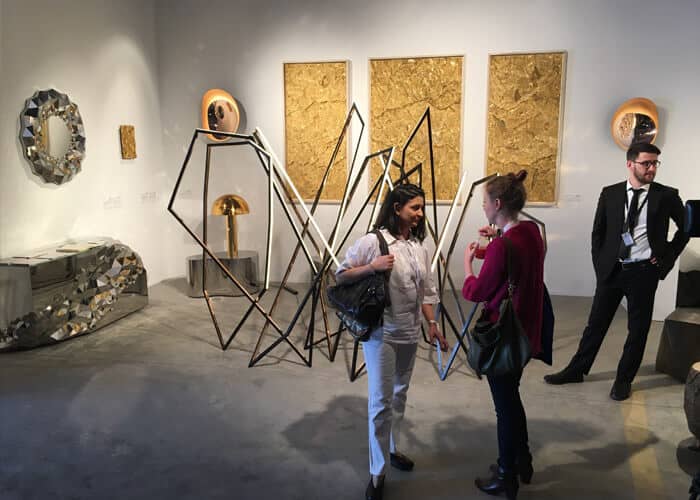 Todd Merrill Studios premiered at Dubai Design Days, 2017. Image courtesy of Brendon Bell-Roberts
Todd Merrill Studios premiered at Dubai Design Days, 2017. Image courtesy of Brendon Bell-Roberts
DESIGN DAYS DUBAI
Having returned for its sixth edition and at a new location within Dubai Design District, Design Days Dubai is the leading fair in the Middle East and South Asia dedicated to collectible modern and contemporary design.
Positioned as a fair of discovery, the fair’s unique format provided an international platform for the region’s emerging design studios and furniture makers to debut their works, featuring them alongside an eclectic mix of the world’s leading design galleries. Running parallel to the exhibitor line-up was a strong non-commercial programme of education, workshops, installations and live performances which allowed visitors to discover and engage with the design community and the works on display.
Running parallel to the exhibitor line-up was a diverse four-day programme of talks, panel discussions, live performances, practical workshops and mentorship sessions which was open to all visitors at no extra charge.
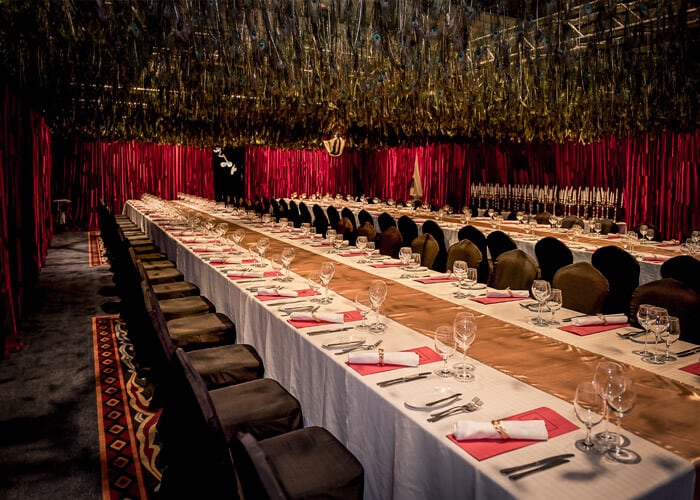 The Room; Cooking Liberty by Atfal Ahdath, Art Dubai Projects 2017, Images courtesy of Art Dubai.
The Room; Cooking Liberty by Atfal Ahdath, Art Dubai Projects 2017, Images courtesy of Art Dubai.
THE ROOM | COOKING LIBERTY
I only like to eat what has a clear and intelligible form. If I hate (…) spinach it is because it is shapeless, like liberty.
From Salvador Dali’s cookbook, Les Diners de Gala
From Salvador Dali’s cookbook, Les Diners de Gala
Cooking Liberty was a visual and gastronomic happening presented by Atfal Ahdath. Far from the revolutionary spirit that drove Breton and his Surrealist accomplices, Cooking Liberty self-consciously poked at the machinations of an art world that empties signs of their significance while maintaining their pristine hollow shell. Surrealist iconic images and visual tropes have been and still are abundantly re-appropriated in mainstream media from advertising to internet memes.
Taking cues from Dali’s book and his oeuvre in general and with the use of exaggeration and repetition, Atfal Ahdath presented the guests with edible dreams in an immersive setting reminiscent of a grandiose banquet. Recipes of famous dishes were structurally and molecularly reconstituted to create contradictory gustative sensations where the intensely sensorial experience flirts with familiarity and expectation. The menu included exquisite dishes as well as sonic, olfactory and visual courses.
Presented by Art Dubai Projects and Atfal Ahdath Artists: Vartan Avakian, Raed Yassin and Hatem Imam Interior Architecture: Antoine Maalouf Architects
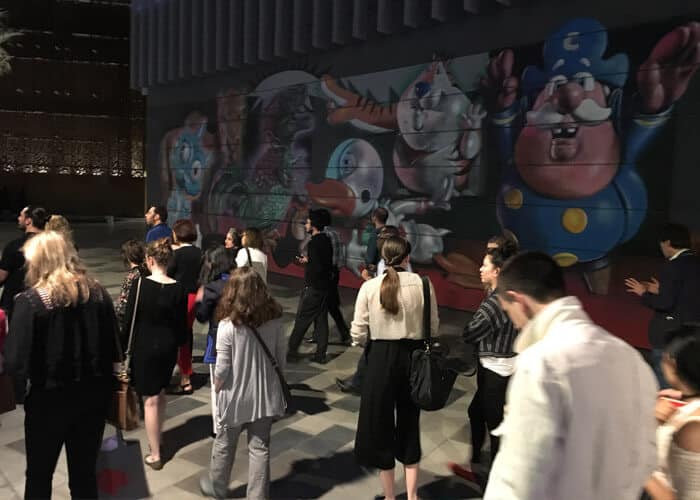 Crowds explore Dubai Walls | City Walks by night at Art Dubai 2017. Image courtesy of Brendon Bell-Roberts.
Crowds explore Dubai Walls | City Walks by night at Art Dubai 2017. Image courtesy of Brendon Bell-Roberts.
DUBAI WALLS | CITY WALKS
There is art in urban life. Not just in physical spaces, but in the patterns created as people move, connect, and go about their lives. This is the active urban life that inspired Dubai Walls, a ground-breaking street art initiative by Meraas.
Street art evolved in the late 20th century and beginning of the 21st century to become one of the most followed artistic expressions in the world. Through Dubai Walls, artists have brought a new dimension of the world’s most exciting art movement to the Middle East. The initiative provides an attractive platform for global admirers of street art, and is designed to attract visitors to the region throughout the year. Dubai Walls is also designed to transform public spaces into permanent street art exhibitions that align with Dubai’s modern landscape, and is an opportunity for visitors and residents to enjoy the beautiful artistic creations.
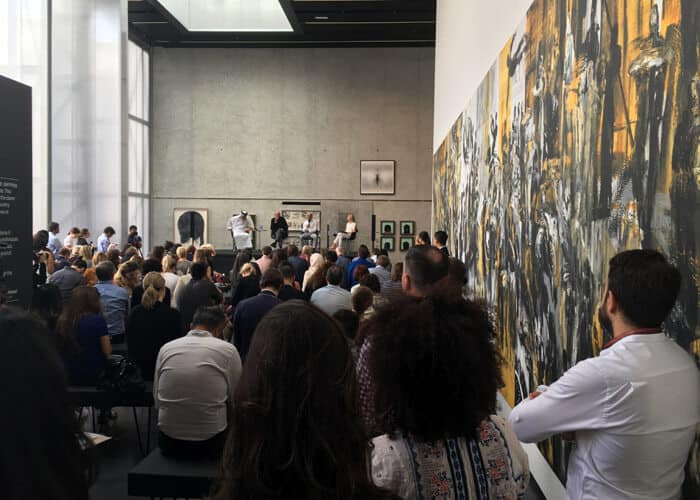 Symposium at the opening of Rem Koolhaas’ CONCRETE in Alserkal Avenue. Image courtesy of Brendon Bell-Roberts.
Symposium at the opening of Rem Koolhaas’ CONCRETE in Alserkal Avenue. Image courtesy of Brendon Bell-Roberts.
CONCRETE
Conceptualised by Alserkal Avenue, and designed by the Office for Metropolitan Architecture (OMA) founded by Rem Koolhaas, Concrete is a multidisciplinary, multipurpose venue located in Alserekal Avenue, Dubai.
This March, Concrete was inaugurated with a comprehensive museum-quality exhibition of modern and contemporary art from Syria, staged in collaboration with the Atassi Foundation. Titled ‘Syria: Into the Light’, the show was organised by curator Rasha Salti and Atassi Foundation co-founder Mouna Atassi. Visitors encountered a full spectrum of Syrian art from modernist masters to emerging artists, including Fateh Moudarres, Toufiq Tarek, Omran Younes, and Youssef Abdelke. The inaugural exhibition was accompanied by talks, screenings, and auxillary commissions around Alserkal Avenue which both extended the exhibition and grounded Concrete in its new Al Quoz home.
Think of architects like Rem Koolhaas, famous for monumental projects like the CCTV headquarters in Beijing, or Rotterdam’s Kunsthal, and cities like Dubai come to mind. His firm, OMA whose recent art-related projects include the Garage Museum of Contemporary Art in Moscow, Miami’s Faena District and the elegiac mourning towers of Taryn Simon’s 2016 ‘An Occupation of Loss’ installation at the Park Avenue Armory in New York.
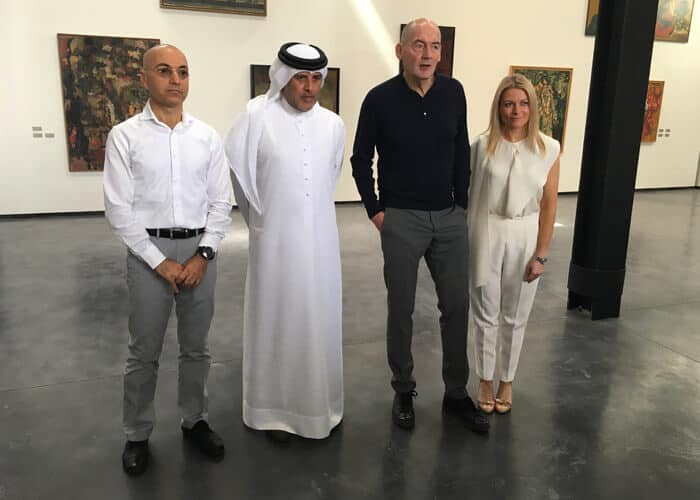 Iyad Alsaka, parter at OMA; Abdelmonem bil Eisa Alserkal, Founder of Alserkal Avenue; Rem Koolhaas, founder of OMA; and Vilma Jurkute, director of Alserkal Avenue at the official press launch of Concrete. Image courtesy of Brendon Bell-Roberts.
Iyad Alsaka, parter at OMA; Abdelmonem bil Eisa Alserkal, Founder of Alserkal Avenue; Rem Koolhaas, founder of OMA; and Vilma Jurkute, director of Alserkal Avenue at the official press launch of Concrete. Image courtesy of Brendon Bell-Roberts.
Spread over four units in Alserkal Avenue, the multipurpose venue builds on these warehouses’ existing shells, much in the way that the residents of the arts neighbourhood build upon their host neighbourhood of Al Quoz. Full-height semi-opaque sliding doors at its entrance echo a similar feature at the aforementioned Garage Museum, while four internal shifting and rotatable walls allow for a truly flexible and responsive use of the nearly 1000 square meter space. When completed, it will primarily be a venue for large-scale public events, such a s exhibitions, installations and performances, but divisible into smaller segments – as tight as 70 square meters – for screenings, conferences and other cultural programming. Sprayed concrete exteriors and simple concrete floors lend the building its name, but the addition of skylights prevent it from feeling like a bunker and flood the space with natural light to blur the distinction between indoors and outdoors.
Little mirrored shards embedded in its rough concrete exterior make the building shimmer in the sun, a new technique for OMA, and perfect for the glitz of a city where even raw concrete is expected to sparkle.
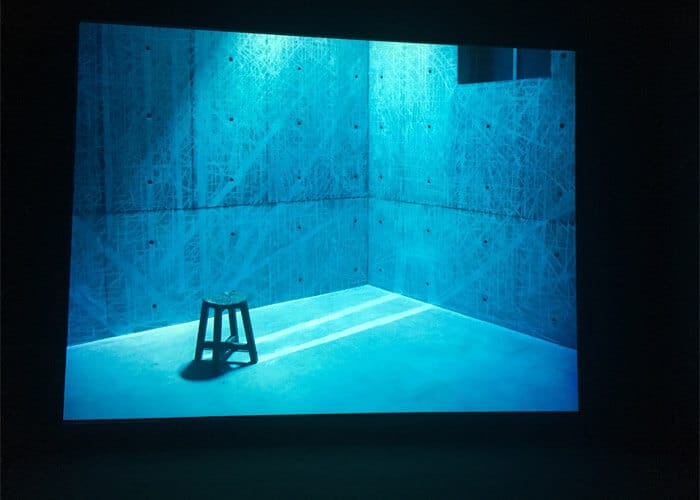 Burning Chair (video still), 2013. Image courtesy of Brendon Bell-Roberts.
Burning Chair (video still), 2013. Image courtesy of Brendon Bell-Roberts.
SHARJAH BIENNIAL
Sharjah Biennial is organised by Sharjah Art Foundation, which brings a broad range of contemporary art and cultural programmes to the communities of Sharjah, the UAE, and the region. Since 1993, Sharjah Biennale has commissioned, produced and presented large-scale public installations, performances and films, offering artists from the region and beyond an internationally recognised platform for exhibition and experimentation.
TAMAWUJ
Taking place from January 2016 to January 2018, Sharjah Biennial 13: Tamawuj (SB13) encompasses exhibitions, projects and education programmes in five locations, expanding the structure of the previous Sharjah biennals across space and time. SB13 includes exhibitions and public programmes in two acts, one in Sharjah (10 March – 12 June 2017) and one in Beirut (October 2017 – January 2018), as well as the SB13 School, a year-long education programme that spans the Western, Central and Eastern regions of Sharjah.
Tamawuj also seeks to mobilise ongoing conversations. Four interlocutors in as many cities have organised projects around keywords that are integral to SB13’s conceptual framework. Kader Attia investigated water in Dakar (8th January 2017), Zeynep Oz will consider crops in Istanbul (opening 13th May 2017), Lara Khaldi will study earth in Ramallah (opening 10th August 2017) and Ashkal Alwan will reflect on the culinary in Beirut (opening 15th October 2017).
In the lead-up to the Biennial, researchers in Sharjah as well as the four other cities assembled materials relating to the key-words for chip-ship, a digital repository available to SB13 artists, and an online publishing platform, tamawuj.org, hosting articles, media and essays as well as compendia related to the four keywords throughout the Biennale for artists, researchers and the general public.
SB13 SCHOOL
The year-long SB13 School is an important component in curator Christine Tohme’s expanded format for Sharjah Biennale 13: Tamawuj. Focusing on crafts, culinary arts, digital arts, farming and music, with a particular emphasis on practical application and active participation, the SB13 School programme supplements and builds upon extensive Sharjah Art Foundation education programming, which seeks to encourage public engagement by cultivating creativity and enriching the cultural experiences of the local community. Rooted in the four keywords forming the conceptual framework of the biennial (water, crops, earth and the culinary), SB13 School programmes take place in Al Hamriyah, Kalba and Al Madam and explore the entire Emirate of Sharjah, drawing on the unique topographical features of the two coastlines as well as the farmland and desert areas in between.
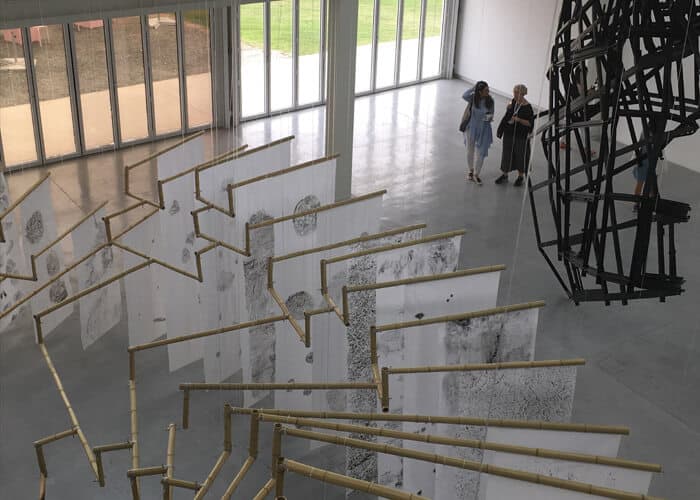 Sharjah Biennial, 2017. Image courtesy of Brendon Bell-Roberts.
Sharjah Biennial, 2017. Image courtesy of Brendon Bell-Roberts.
SHARJAH ART FOUNDATION
Sharjah Art Foundation brings a broad range of contemporary art and cultural programmes to the communities of Sharjah, the UAE and the region. Since 2009 SAF has built on the history of cultural collaboration and exchange that began with the first Sharjah Biennial in 1993. Working with local and international partners, we create opportunities for artists and artistic production through our core initiatives that include the Sharjah Biennial, the annual March Meeting, residencies, production grants, commissions, exhibitions, research, publications and growing collection. The education and public programmes focus on building recognition of the central role art can play in the life of a community by promoting public learning and a participatory approach to art.
AL HAMRIYAH
Sharjah Art Foundation (SAF) inaugurated Al Hamriyah Studios on the 19th February 2017. HH Sheikh Dr Sultan Al Qasimi, member of the Federal Supreme Council and Ruler of Sharjah, officially opened the new artist workspaces and exhibition areas.
Situated on the Sharjah coast at Al Hamriyah, the latest addition to SAF’s off-site venues allows the Foundation to expand and diversify its programming outside the central exhibition spaces in Arts Square and the Heritage Area to include the whole of the Emirate of Sharjah. In close proximity to Ajman, Umm Al Quwain and Ras Al Khaimah, Al Hamriyah Studios also extends the Foundation’s outreach activities to different local communities in the northern Emirates.
Programmes at the new venue will build on already established education initiatives in the local area. At Al Hamriyah Art Centre, one of the Foundation’s six art centres across the central and eastern regions of the Emirate, SAF programming has engaged local audiences through a focus on education workshops ranging from painting, sculpture, and calligraphy to ceramics and photography. As part of Sharjah Biennial 13: Tamawuj (SB13), SB13 School – a special year-long education programme – offered workshops in Al Hamriyah that were rooted in the four keywords forming the conceptual framework of the biennale (water, crops, earth and culinary). In addition, Al Hamriyah Studios was one of the venues exhibiting existing works as well as newly commissioned projects.
In his design of Al Hamriyah Studios, Emirati architect Khaled Al Najjar of the award-winning local firm dxb.lab combines avant-garde and modern architectural technologies with regionally-inspired customs and traditions of the built environment. In keeping with SAF’S other urban development projects, which have readapted historic architectural elements to new uses, Al Hamriyah Studios were constructed on the site of a former souq. Conversing with the site’s history and prior use as an introverted market space, the footprint of the courtyard and periphery have largely been maintained and transformed into an open, more fluid space, which allows for a communal social and spatial experience around contemporary art.
The 2510.8 m2 community space will enable artists to concentrate on the production of artworks while engaging with other artists. The hubs of social interaction are the 761.8 m2 courtyard, the large multi-purpose room and the pantry space with its large communal table. Landscaped with local trees and plants, the courtyard will play host to a range of SAF public events, including outdoor cinema screenings and performances.
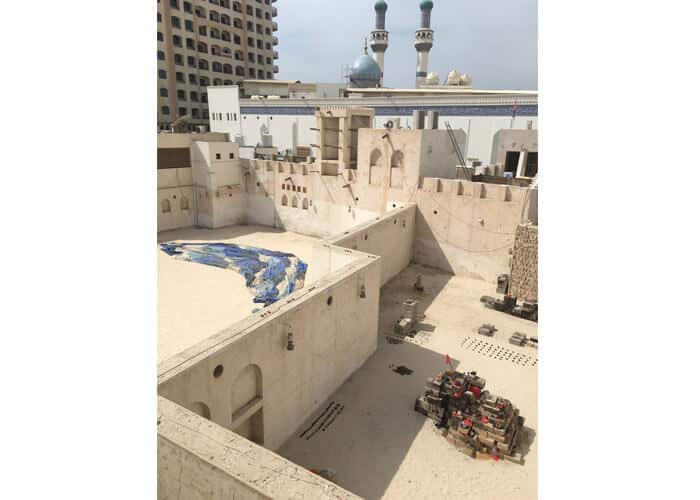 Sharjah Biennial, 2017. Image courtesy of Brendon Bell-Roberts.
Sharjah Biennial, 2017. Image courtesy of Brendon Bell-Roberts.
TAMAWUJ.ORG
For the publishing platform, tamawuj.org, Tohme has invited four editors – Omar Berrada, Amal Issa, Kaelen Wilson-Goldie and Brian Kuan Wood – to collaborate closely with the SB13 interlocutors in developing content that expands upon the four keywords of water, crops, earth and culinary. Featuring essays, images, videos, experimental writings, fragmentary texts and other audio-visual materials in Arabic, English, French and Turkish, the platform functions as a site of inquiry and reflection for a wider audience. With the aim of making research accessible, commissioned content for the publishing platform will be compiled into four downloadable compendia. Each compendium will focus on one of the four keywords and the release will coincide with the start of its corresponding off-site project: water in Dakar (8th January 2017), crops in Istanbul (13th May 2017), earth in Ramallah (10th August 2017) and the culinary in Beirut (15th October 2017).
The first compendium on water, is now available and it includes articles by Saloua Luste Boulbina, Victoria Ivanova and Ibrahima Wane.
CHIP-SHIP
Launched on the 15th October 2016, chip-ship is an online repository for textual, visual and auditory data related to the four SB13 keywords. The material was collated over eight months by 15 researchers located in Dakar, Istanbul, Ramallah, Beirut and Sharjah. With essays, archival material and commissioned topical research, the cloud-hosted chip-ship server is a rich source of data created by the interlocutors during the research phase of their respective off-site projects. The wordplay in the title emphasises a digital aspect of the data server as a vessel of knowledge. This repository serves as a ‘lighthouse’ to engage SB13 knowledge. Chip-ship will become a permanent archive of SB13, functioning as a record of the Biennale and extending its life beyond 2017.
Launched on the 15th October 2016, chip-ship is an online repository for textual, visual and auditory data related to the four SB13 keywords. The material was collated over eight months by 15 researchers located in Dakar, Istanbul, Ramallah, Beirut and Sharjah. With essays, archival material and commissioned topical research, the cloud-hosted chip-ship server is a rich source of data created by the interlocutors during the research phase of their respective off-site projects. The wordplay in the title emphasises a digital aspect of the data server as a vessel of knowledge. This repository serves as a ‘lighthouse’ to engage SB13 knowledge. Chip-ship will become a permanent archive of SB13, functioning as a record of the Biennale and extending its life beyond 2017.

